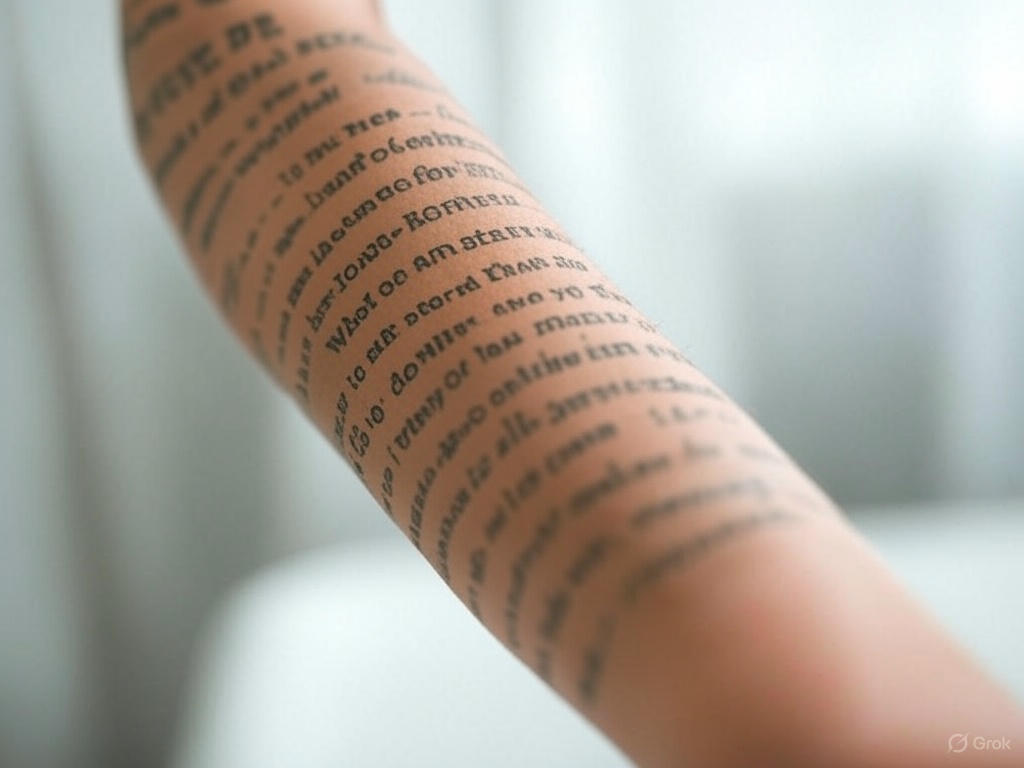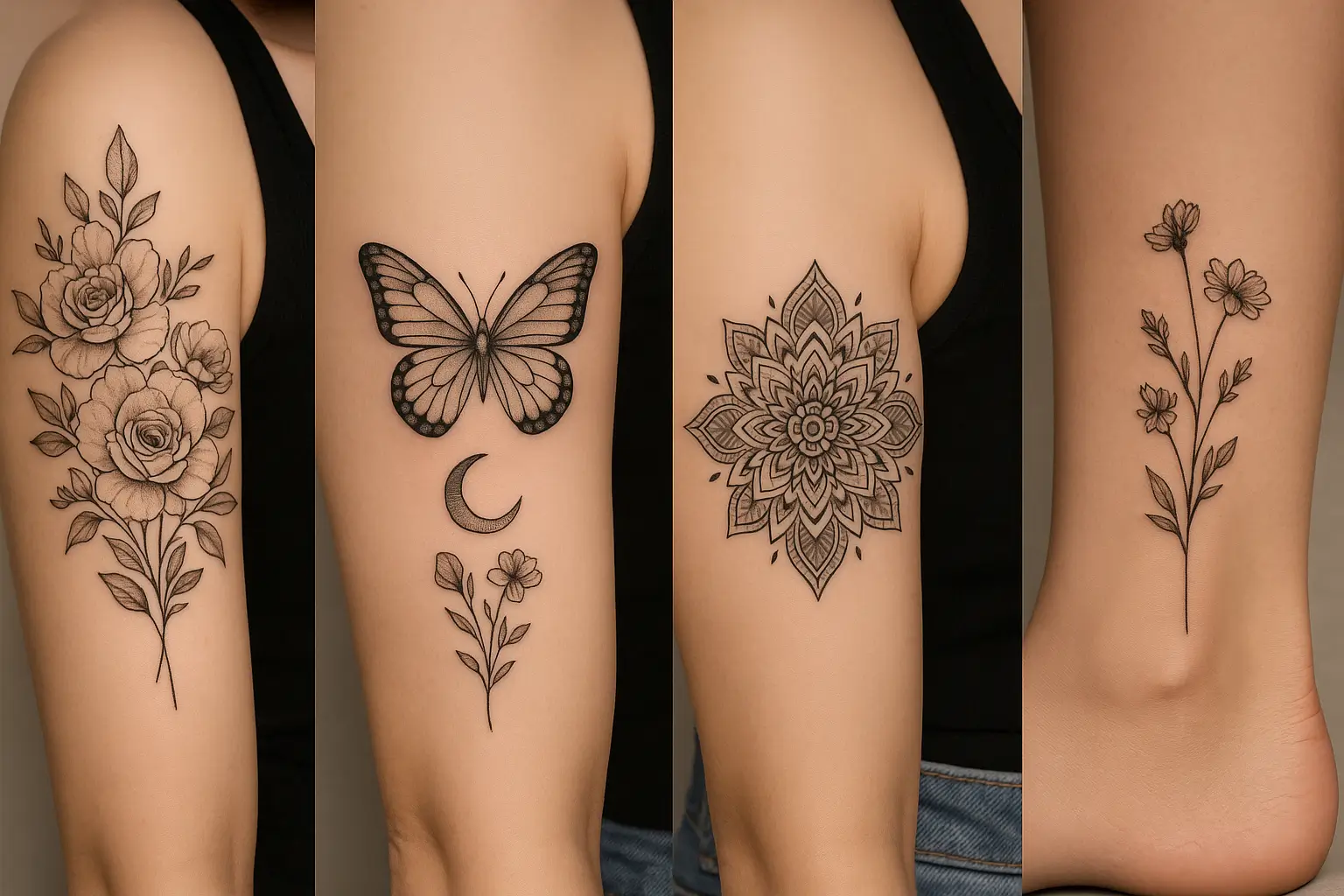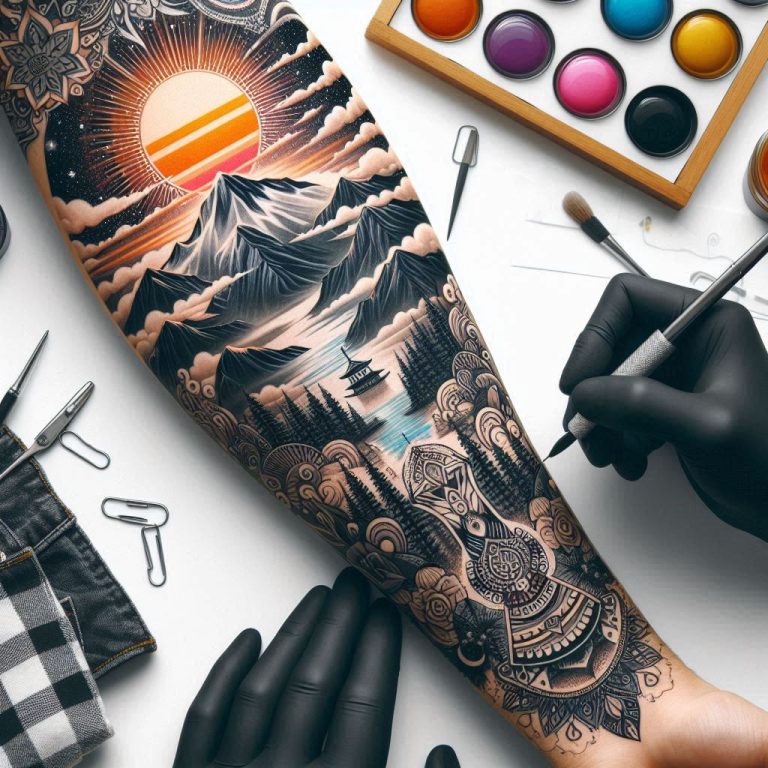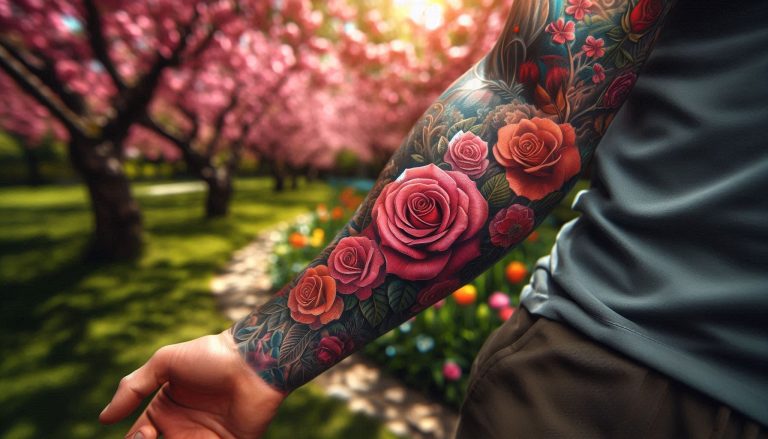Tattoo Ideas for Women
Tattoo Ideas for Women
With art permanently inked onto their skin, tattoos are a potent way for women to express their uniqueness, convictions, and inventiveness. The world of tattoos offers countless options, ranging from strong, elaborate designs to delicate, minimalist styles. The common themes, places, and designs of tattoos for women are covered in this article to help you come up with ideas for your next ink.
Why Tattoos Are Popular Among Women
As social stigmas diminish and the art form is acknowledged for its beauty and adaptability, tattoos have grown in popularity among women. A tattoo can be a wearable work of art, a memorial to a loved one, or a personal milestone. Women may now select designs that complement their look thanks to developments in tattooing technology, regardless of whether they like understated elegance or striking vibrancy.
Popular Tattoo Themes for Women
Women’s popular tattoo designs frequently incorporate symbolism, beauty, and self-expression. Roses, lotuses, and cherry blossoms are classic floral patterns that represent femininity, growth, and resiliency. Those looking for subtle yet meaningful ink are drawn to minimalist tattoos, such as delicate line art, tiny hearts, or celestial patterns like stars and moons. Tattoos with animal themes—especially those of birds, butterflies, or cats—stand for liberty, change, or self-reliance. Quote tattoos, which are frequently written in beautiful calligraphy, express motivational sayings or personal mantras. Furthermore, ladies who value uniqueness and body art storytelling are drawn to cultural or spiritual symbols like dreamcatchers or mandalas because of their deeper connotations and elaborate designs.
Floral Designs


Women frequently choose tattoos with floral designs because of their beauty, adaptability, and deep symbolic meaning. Lotuses stand for purity and spiritual development, while roses, which are frequently inked in vivid reds or gentle pastels, symbolize love, passion, or tenacity. With their delicate pink petals, cherry blossoms invoke concepts of rebirth and life’s transient nature. These arrangements, which frequently include vines or leaves for extra beauty, can range from simple single blooms to elaborate, ornate bouquets. In order to blend in with the natural contours of the body, floral tattoos are commonly applied to places like the thigh, shoulder, or forearm. Their enduring appeal stems from their capacity to use nature’s most striking imagery to communicate intimate tales and feelings.
- Roses: Represent love, passion, or resilience (especially with thorns).
- Lotus: Signifies overcoming adversity and purity.
- Cherry Blossoms: Symbolize the fleeting nature of life and renewal.
- Peonies: Associated with prosperity and honor.
Idea: A delicate vine of roses wrapping around the forearm or a single lotus on the wrist for a minimalist touch.
Nature Inspired Tattoos


Those who feel a connection to nature will find great resonance in nature-inspired tattoos, which enthrall with their celebration of the earth’s beauty and symbolism. These designs frequently incorporate motifs like mountains, which stand for resiliency and adventure, or trees, which symbolize strength and growth. While animal imagery—think wolves, deer, or owls—embodies qualities like independence, wisdom, or loyalty, water motifs—like waves or rivers—evoke fluidity and transformation. Because they may combine creative flair with realism, intricate elements like a waterfall or a forest silhouette are appealing. As a personal tribute to the wild and untamed, nature-inspired tattoos are frequently applied on the arm, back, or chest and are usually etched in earthy tones or bold black ink. displayed on the sidebar
- Trees: Symbolize strength and growth.
- Birds: Represent freedom and aspiration.
- Mountains or Waves: Reflect adventure and resilience.
Idea: A small flock of birds flying across the collarbone or a wave design on the ankle for a subtle nod to the ocean.
Minimalist and Geometric Designs

Geometric and minimalist designs create visually arresting compositions with few components by emphasizing functionality, simplicity, and clean lines. Based on the idea that “less is more,” minimalist design eliminates extraneous details in favor of core shapes, muted hues, and open areas to promote serenity and clarity. This is enhanced by geometric design, which uses shapes like squares, triangles, and circles organized in exact, frequently symmetrical patterns to produce harmony and balance. When combined, they create classic, adaptable images that are frequently utilized in product, graphic, and architectural design, providing both visual appeal and useful purpose.
- Single-Line Art: A face or animal drawn with one continuous line.
- Geometric Shapes: Triangles, circles, or hexagons symbolizing balance or harmony.
- Tiny Symbols: Hearts, stars, or arrows for a discreet yet personal touch.
Idea: A tiny crescent moon on the finger or a geometric heart on the wrist.
Quotes and Words


Words and quotes have great potential to influence people’s ideas, motivate them to take action, and bridge gaps in time and location. A well-written quotation has the power to condense difficult feelings or concepts into a few moving words that have a profound impact on the reader. Words are the foundation of communication, whether they are written or spoken, and they can convey comfort, comedy, or wisdom. Quotations and words, from old proverbs to contemporary mantras, remind us of our common hardships, victories, and goals while weaving a tapestry of the human experience.
- Mantras: Words like “Breathe,” “Fearless,” or “Serenity.”
- Poetry or Lyrics: Short excerpts from favorite songs or poems.
- Names or Dates: Tributes to family, partners, or significant moments.
Idea: The word “Resilient” in elegant script along the ribcage or a meaningful date in Roman numerals on the shoulder.
Mythical and Spiritual Symbols

Across cultures and time periods, mythical and spiritual symbols have functioned as potent means of conveying meaning, encapsulating deep convictions, universal truths, and human desires. From the elaborate mandalas of Buddhism and Hinduism, which symbolize world harmony, to the ancient Egyptian ankh, which symbolizes perpetual life, these icons transcend words and communicate difficult spiritual ideas in straightforward yet powerful ways. The Native American dreamcatcher is thought to filter dreams and shield against negative energies, while the Celtic triskele symbolizes cycles of life, death, and rebirth. Such symbols, whether carved into stone, woven into fabrics, or worn as talismans, are frequently derived from mythology or sacred stories and serve to unite people with the divine and the universe by connecting them to their cultural history, spiritual practices, and the mysteries of life.

- Mandala: Represents balance and unity, often intricately designed.
- Moon Phases: Symbolize cycles, growth, and femininity.
- Goddess Symbols: Figures like Athena or Venus for empowerment.
Idea: A mandala on the upper back or a series of moon phases along the spine.
Animal Tattoos


Popular body art, animal tattoos represent a strong bond with nature, individual characteristics, or cultural values. These tattoos, which are frequently selected for their visual appeal and symbolic significance, might stand for attributes like loyalty (wolves), strength (lions), or freedom (birds). Animal tattoos accommodate a wide range of artistic tastes, from detailed, lifelike representations to simple or tribal patterns. These tattoos are an effective way to express oneself and convey a tale because many people choose animals that represent their personalities or life experiences.
- Butterflies: Symbolize transformation and beauty.
- Wolves: Represent loyalty and independence.
- Cats: Evoke mystery and grace.
Idea: A small butterfly on the shoulder blade or a realistic wolf portrait on the thigh.
Cultural and Heritage-Inspired Designs
Tattoos with cultural and heritage-inspired designs are potent ways for people to express who they are and link to their ancestry, customs, and history. These tattoos frequently reference culturally particular symbols, motifs, and artistic expressions, such as Celtic knots, Native American animal totems, Japanese Irezumi, or Polynesian tribal designs. Wearers maintain cultural legacies, commemorate their ancestry, and express individual or group pride by combining components such as historical narratives, holy iconography, or traditional patterns. Often representing beliefs, rites of passage, or historical resiliency, these designs have profound spiritual or symbolic connotations. To prevent cultural appropriation, they also call for tact, stressing the value of contextual awareness, working with experienced artists, and honoring the imagery’s original sources. When carefully considered, these tattoos serve as links between the past and present, fusing traditional artistic expression with contemporary self-expression and promoting an understanding of the world’s rich cultural diversity.
- Celtic Knots: Symbolize eternity and interconnectedness.
- Polynesian Patterns: Represent strength and community.
- Henna-Inspired Designs: Intricate patterns with a bohemian flair.
Idea: A Celtic knot on the wrist or a henna-style design on the hand.
Popular Tattoo Placements for Women
The placement of a tattoo can enhance its impact and complement the body’s natural contours. Here are some favored spots:
- Wrist: Ideal for small, delicate designs like flowers or words.
- Ankle: Perfect for discreet tattoos like stars or birds.
- Ribcage: Offers a large canvas for quotes or sprawling floral designs.
- Back/Spine: Suits vertical designs like moon phases or vines.
- Shoulder/Collarbone: Great for subtle designs that can be shown or hidden.
- Thigh: A bold choice for larger, detailed pieces like animals or mandalas.
Tip: Consider your pain tolerance and lifestyle. Areas like the ribcage or spine can be more painful, while wrists and ankles are easier to heal but more visible.
Tattoo Styles to Consider
The style of a tattoo can dramatically affect its appearance. Here are some popular styles for women:
- Watercolor: Vibrant, painterly designs with soft edges, often used for florals or animals.
- Blackwork: Bold, solid black ink for geometric or tribal designs.
- Fine Line: Delicate, precise lines for minimalist or detailed work.
- Neo-Traditional: Combines bold outlines with vivid colors and modern twists.
- Dotwork: Uses tiny dots to create shading and texture, ideal for mandalas.
Tips for Choosing Your Tattoo
- Reflect on Meaning: Choose a design that resonates with your values, experiences, or aspirations.
- Research Artists: Look for tattoo artists who specialize in the style you want. Check their portfolios for consistency and skill.
- Consider Longevity: Think about how the design will age and whether it will remain meaningful to you.
- Start Small: If it’s your first tattoo, opt for a smaller design in a less painful area to test the waters.
- Plan for Visibility: Decide if you want your tattoo to be easily hidden for professional or personal reasons.
Caring for Your Tattoo
Proper aftercare ensures your tattoo heals beautifully:
- Keep it Clean: Wash gently with fragrance-free soap and water.
- Moisturize: Apply a thin layer of tattoo-specific ointment or unscented lotion.
- Avoid Sun Exposure: Protect your tattoo from direct sunlight to prevent fading.
- Don’t Scratch: Let any scabs or peeling skin heal naturally.
Conclusion
Tattoos are a celebration of individuality, and for women, the options are as diverse as their stories. Whether you’re drawn to the delicate beauty of a floral wrist tattoo, the bold statement of a thigh mandala, or the subtle elegance of a minimalist design, there’s a tattoo idea that’s perfect for you. Take your time to explore themes, styles, and placements, and work with a skilled artist to bring your vision to life. Your tattoo is not just art—it’s a piece of your journey, forever etched in ink.



